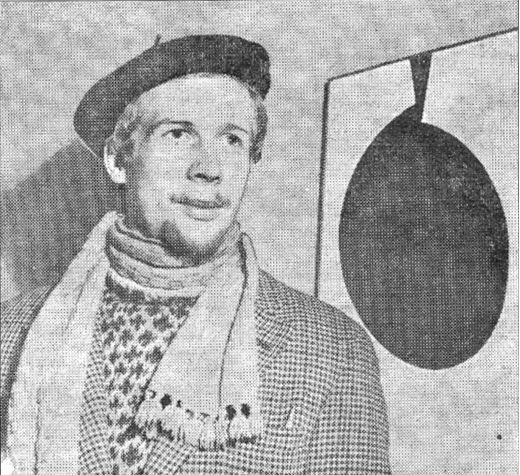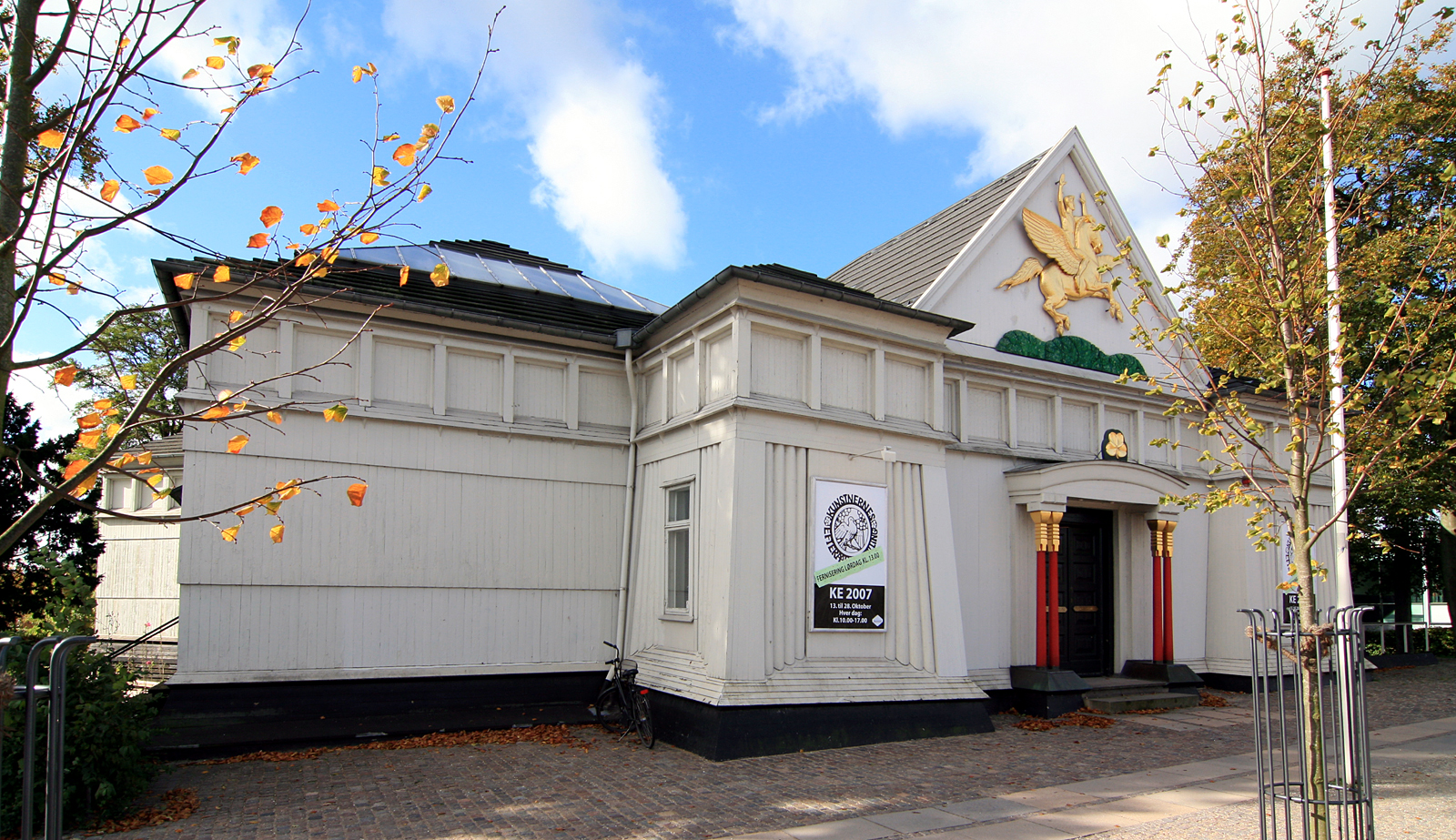|
Ole Schwalbe
Ole Albert Christian Schwalbe (23 July 1929 – 15 October 1990) was a Danish painter. He was one of the painters in the Linien artists association who in 1956 initiated the second generation of Danish Constructivism which they called concrete realism. Biography Born in the Brønshøj district of Copenhagen, Schwalbe was self-taught as a painter but was trained as a printmaker from 1945 to 1950. He first exhibited at the Kunstnernes Efterårsudstilling (Artists Autumn Exhibition) in 1945 when he was only 16. Schwalbe was one of the Linien painters who in 1956 initiated the second generation of Danish Constructivism which they called concrete realism. After experimenting with colour, in 1953 he decided to limit himself to black and white, forming positive and negative segments of circles like the marks made by a paperclip. In the late 1950s, he added red to the black and white in order to represent the three most important aspects of existence: life and death, body, and soul. Aroun ... [...More Info...] [...Related Items...] OR: [Wikipedia] [Google] [Baidu] |
Linien
Linien (meaning "The Line") was an artists' association in Denmark in the 1930s and 1940s focusing on Abstraction and Symbolism. The group's exhibitions in Copenhagen created wide international participation. After the Second World War, the association was revived as Linien II with an emphasis on Concrete art. Background In the 1930s, art moved into a new phase experiments in the theoretical and intellectual use of shapes and symbols while at the same time a symbolism emerged from the world of dreams. This was the basis for Concrete art and Surrealism which became the latest trend in the international Avant-garde movement. The association of Abstraction and Surrealism was pioneered by Vilhelm Bjerke-Petersen who in 1930 joined the Bauhaus School in Weimar, a key Avant-garde institution which revolutionized not just painting but architecture, sculpture, literature, theatre and dance. Bauhaus is remembered for its influence on Abstract art and Functionalist architecture and desig ... [...More Info...] [...Related Items...] OR: [Wikipedia] [Google] [Baidu] |
Constructivism (art)
Constructivism is an early twentieth-century art movement founded in 1915 by Vladimir Tatlin and Alexander Rodchenko. Abstract and austere, constructivist art aimed to reflect modern industrial society and urban space. The movement rejected decorative stylization in favor of the industrial assemblage of materials. Constructivists were in favour of art for propaganda and social purposes, and were associated with Soviet socialism, the Bolsheviks and the Russian avant-garde. Constructivist architecture and art had a great effect on modern art movements of the 20th century, influencing major trends such as the Bauhaus and De Stijl movements. Its influence was widespread, with major effects upon architecture, sculpture, graphic design, industrial design, theatre, film, dance, fashion and, to some extent, music. Beginnings Constructivism was a post-World War I development of Russian Futurism, and particularly of the 'counter reliefs' of Vladimir Tatlin, which had been exhibited ... [...More Info...] [...Related Items...] OR: [Wikipedia] [Google] [Baidu] |
Brønshøj
Brønshøj, part of the municipality of Copenhagen, forms, together with Husum, the administrative city district (''bydel'') of Brønshøj-Husum, in Denmark. History The first mention of the village Brønshøj (Brunshoga), is in a letter dated October 21, 1186 from Pope Urban III to Archbishop Absalon. Brønshøj Church dates from approximately the same time. In 1658-1660, during The Northern Wars, the village and its immediate surroundings were transformed into a military fortress and town, named Carlstad by the Swedish Army under the command of King Karl X Gustav. This town supported the Swedish siege of Copenhagen. The population reached c. 30,000, which was the same as that of Copenhagen itself. The siege ended on the death of Karl X Gustav, 13 February 1660. Evidence of the fortifications cannot be found in the landscape today, though many artifacts have been uncovered. Artifacts and models of Carlstad and the events surrounding its creation are found at Brønshøj Museum. D ... [...More Info...] [...Related Items...] OR: [Wikipedia] [Google] [Baidu] |
Kunstnernes Efterårsudstilling
Den Frie Udstilling ('The Free Exhibition') is a Danish artists' association, founded in 1891 by artists in protest against the admission requirements for the Kunsthal Charlottenborg. Modeled on the Salon des Refusés, it is Denmark's oldest association of artists. Now located on Copenhagen's Oslo Plads next to Østerport Station, it works as an arts centre, continuing to exhibit works created and selected by contemporary artists rather than those chosen by cultural authorities. History The organization was initiated by the painter Johan Rohde (1856–1935) and included several founding members: Jens Ferdinand Willumsen, Anne Marie Carl-Nielsen, Vilhelm Hammershøi, Johanne Cathrine Krebs, the couple Harald and Agnes Slott-Møller, Christian Mourier-Petersen and Malthe Engelsted. The first exhibition in 1891 presented 100 works by 18 artists, including Peder Severin Krøyer, Julius Paulsen and Kristian Zahrtmann, who were among Denmark's greatest painters of the period. [...More Info...] [...Related Items...] OR: [Wikipedia] [Google] [Baidu] |
Thorvaldsen Medal
The Thorvaldsen Medal (Danish: Thorvaldsens Medalje, Thorvaldsen Medaillen) is awarded annually with few exceptions to a varying number of recipients by the Royal Danish Academy of Fine Arts and is its highest distinction within the visual arts. It is named after the sculptor Bertel Thorvaldsen. The medal was founded in 1837 as the Exhibition Medal and awarded for talented works in the Charlottenborg Spring Exhibition in the Charlottenborg Palace. In 1866, it was renamed the Thorvaldsen Exhibition Medal ( da, Thorvaldsenske Udstillings-Medaille), and from 1923 it has been known under its current name. Medal design The medal is executed in silver and designed by the sculptor Christen Christensen (1806–45) in connection with Thorvaldsen's homecoming from Rome in 1838. Recipients Exhibition Medal recipients Thorvaldsen Medal recipients See also * Art of Denmark * C. F. Hansen Medal * Eckersberg Medal * List of European art awards * Prizes named after people A prize is a ... [...More Info...] [...Related Items...] OR: [Wikipedia] [Google] [Baidu] |
1929 Births
Nineteen or 19 may refer to: * 19 (number), the natural number following 18 and preceding 20 * one of the years 19 BC, AD 19, 1919, 2019 Films * ''19'' (film), a 2001 Japanese film * ''Nineteen'' (film), a 1987 science fiction film Music * 19 (band), a Japanese pop music duo Albums * ''19'' (Adele album), 2008 * ''19'', a 2003 album by Alsou * ''19'', a 2006 album by Evan Yo * ''19'', a 2018 album by MHD * ''19'', one half of the double album ''63/19'' by Kool A.D. * ''Number Nineteen'', a 1971 album by American jazz pianist Mal Waldron * ''XIX'' (EP), a 2019 EP by 1the9 Songs * "19" (song), a 1985 song by British musician Paul Hardcastle. * "Nineteen", a song by Bad4Good from the 1992 album '' Refugee'' * "Nineteen", a song by Karma to Burn from the 2001 album ''Almost Heathen''. * "Nineteen" (song), a 2007 song by American singer Billy Ray Cyrus. * "Nineteen", a song by Tegan and Sara from the 2007 album '' The Con''. * "XIX" (song), a 2014 song by Slip ... [...More Info...] [...Related Items...] OR: [Wikipedia] [Google] [Baidu] |
1990 Deaths
Year 199 ( CXCIX) was a common year starting on Monday (link will display the full calendar) of the Julian calendar. At the time, it was sometimes known as year 952 '' Ab urbe condita''. The denomination 199 for this year has been used since the early medieval period, when the Anno Domini calendar era became the prevalent method in Europe for naming years. Events By place Roman Empire * Mesopotamia is partitioned into two Roman provinces divided by the Euphrates, Mesopotamia and Osroene. * Emperor Septimius Severus lays siege to the city-state Hatra in Central-Mesopotamia, but fails to capture the city despite breaching the walls. * Two new legions, I Parthica and III Parthica, are formed as a permanent garrison. China * Battle of Yijing: Chinese warlord Yuan Shao defeats Gongsun Zan. Korea * Geodeung succeeds Suro of Geumgwan Gaya, as king of the Korean kingdom of Gaya (traditional date). By topic Religion * Pope Zephyrinus succeeds Pope Victor I, as ... [...More Info...] [...Related Items...] OR: [Wikipedia] [Google] [Baidu] |
Artists From Copenhagen
An artist is a person engaged in an activity related to creating art, practicing the arts, or demonstrating an art. The common usage in both everyday speech and academic discourse refers to a practitioner in the visual arts only. However, the term is also often used in the entertainment business, especially in a business context, for musicians and other performers (although less often for actors). "Artiste" (French for artist) is a variant used in English in this context, but this use has become rare. Use of the term "artist" to describe writers is valid, but less common, and mostly restricted to contexts like used in criticism. Dictionary definitions The ''Oxford English Dictionary'' defines the older broad meanings of the term "artist": * A learned person or Master of Arts. * One who pursues a practical science, traditionally medicine, astrology, alchemy, chemistry. * A follower of a pursuit in which skill comes by study or practice. * A follower of a manual art, such as a m ... [...More Info...] [...Related Items...] OR: [Wikipedia] [Google] [Baidu] |



